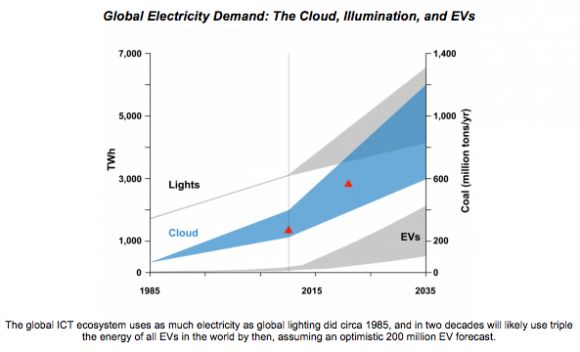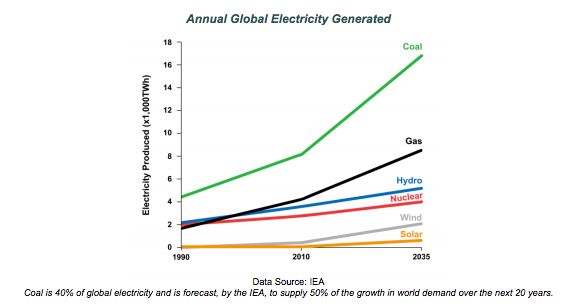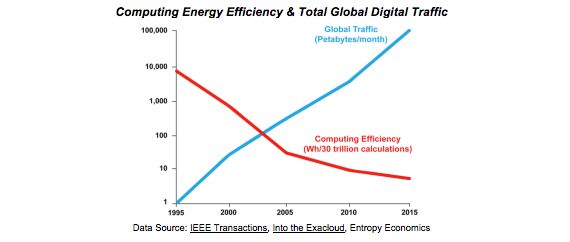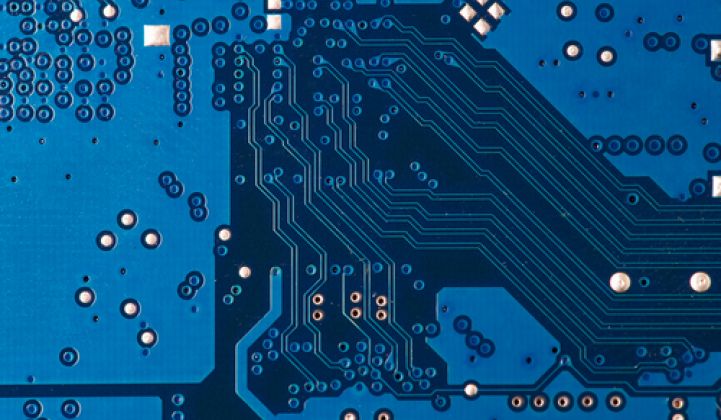The world is on track to hit a major milestone. In the coming decades, the global economy will soon use more energy for electricity production than it does for anything else, aside from transportation.
That shift already occurred in the mid-1990s in the U.S. And over the next two decades, as the world becomes increasingly electricity-centric due to the proliferation of information technologies, that crossover will occur globally.
"The appetite for bits shows no bounds. Even prosperity for emerging economies is no longer measured by the penetration of electricity and light bulbs (though that is still vital), but by bits-per-capita," writes Mark Mills, a senior fellow at the Manhattan Institute, in a new research paper documenting the rise of the information-based economy.
Mills points out some pretty eye-opening statistics. The IT sector now accounts for 10 percent of global electricity consumption -- the same amount of electricity consumed by the global lighting sector in 1985. And the energy used to power the world's current IT needs is 50 percent more than that used for the entire aviation sector.
So what does the rise of global IT energy consumption look like? Mills' report is filled with dozens of fascinating charts on the growing IT landscape. Here are some of the most compelling insights.
1. We have now entered the "zetabyte era." Mills points out that hourly internet traffic could soon exceed yearly internet traffic from the year 2000.

2. IT uses as much electricity as the lighting sector did in the '80s. The incredible rise in the demand for bytes means a corresponding rise in electricity consumption. And developing countries have only gotten started. Mills estimates that China's broadband use alone has accounted for between 100 and 200 terawatt-hours of added yearly electricity use.

3. Smaller doesn't necessarily mean cleaner. The future is mobile. Sales of mobile devices like smartphones and tablets are set to surge past personal computers. However, Mills reports that watching an hour of video per week on a mobile device consumes more electricity over the course of a year than two new Energy Star refrigerators -- when factoring in the emboddied energy of network wireless operations . And as we reported previously, the surge in gadgets is helping offset reductions in home energy consumption in the U.S., even as appliances get cleaner.

4. Our digital universe still revolves around coal. Coal is still the dominant source of electricity production globally. Under a business-as-usual scenario, the International Energy Agency expects coal to supply half of the world's electricity over the next couple of decades. (The changing economics of renewables, along with pollution, climate and water concerns are slowing some coal development, but the sector continues to grow.) That leads Mills to conclude that "the digital universe and cloud begins and ends with coal."

5. An increase in efficiency means more consumption. There's much debate about whether efficiency actually encourages more resource consumption economy-wide, thus creating a "rebound effect." Mills argues that is what's happening in computing. As efficiency of computing has vastly improved, we have seen a corresponding rise in data consumption. Interestingly, Mills concludes that a microprocessor in 1995 used about 40 pounds of coal. Although a microprocessor today is 30 times faster than one in the mid '90s, it also uses ten times more power -- meaning it requires about 400 pounds of coal per year to operate.

However, Mills' report only covers one half of the equation, completely avoiding the economy-wide efficiency impacts of IT -- a concept GTM refers to as "intelligent efficiency."
A 2012 report from ACEEE estimated that IT could increase U.S. energy efficiency by up to 22 percent by improving public transit, energy infrastructure development, shipment of goods and a whole range of other services. And a report from the Carbon War Room released earlier this year concluded that machine-to-machine connections enabling more efficient use of equipment could bring more carbon emission reductions than the green buildings and renewable energy sectors combined.



